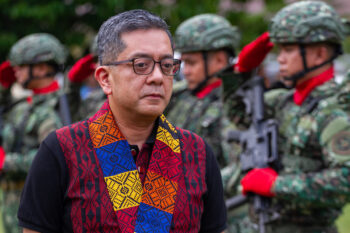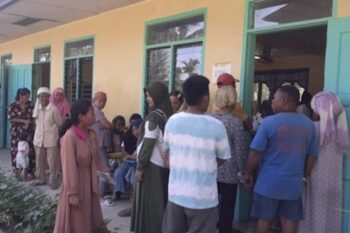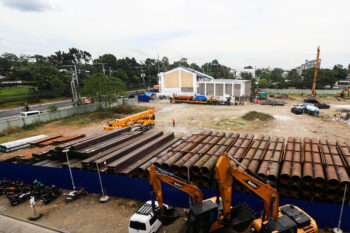BERN, Switzerland (MindaNews/01 March) – With a little time on my hands, I made online investigations on an infrastructure project of the Duterte administration that had caught my interest because it was literally groundbreaking.
The Metro Manila Subway Project will cover 36 kilometers underground, stretching from Valenzuela on the capital’s northern end to the Ninoy Aquino International Airport in Pasay, and promised a very quick trip of only 30 minutes from end to end.
The subway will span seven cities and municipalities and three business districts, and Finance Secretary Carlos Dominguez calls the subway the “biggest single project” under the P8-trillion program dubbed “Dutertenomics.”
The underground subway –the first ever in Metro Manila — is certainly a fantasy of the long-suffering Metro Manila commuter who endures chaos and the traffic gridlock daily.
The administration has also put big stakes on it, with Dominguez saying that the timely completion of the subway project “will crown the aggressive infrastructure program the administration of President Duterte has initiated.”
And the project cost is also staggering—a 104.5 billion yen (P51.3 billion) loan from Japan through the Japan International Cooperation Agency or JICA. How the loan will be paid off, and at what rates of interest, were not detailed in the news items I had found online.
But there is high expectation for the project from a public that has grown tired of the bureaucratic malaise shown by the past administrations. The timely completion of the project, I imagine, may even make or break the administration’s highly-touted “Build, Build, Build” infrastructure plans and what the public will think of it in the future.
The transportation department has promised to open the first three stations in Valenzuela, Tandang Sora and North Avenue before president Duterte’s term ends in 2022.
In an interview over ABS-CBN radio that I had caught by chance, transport secretary Art Tugade had even allayed the concerns of the two program anchors over Manila’s perennial flooding, as well as the danger over the earthquake fault that is located in Manila. No fears, said Tugade, saying that they are using Japanese technology to make the structure flood- and earthquake-proof.
Under the design-build contract, the joint venture of Shimizu Corp, Fujita Corp, Takenaka Civil Engineering Co Ltd., and EEI Corp will design and build the first 3 stations, tunnel structures, subway’s Valenzuela depot, and PH Railway Institute facilities, said a government report.
I wish the project well, as it clearly will benefit Manila commuters. But another thought nags me.
I think back to the airport in my hometown Surigao City, which was damaged in the magnitude 6.7 earthquake that hit in February 2017. Secretary Tugade was in the city soon after, and so was President Duterte, and even special assistant to the president Bong Go last year. All of them had promised the quick repair of 700 meters of the runway that was severely damaged by the quake.
The damage was named the reason for limiting direct flights to Surigao. Since February 2017, Surigao air travelers had endured going to the nearest city of Butuan (some 3 hours away by bus) to fly to Manila and Cebu or to other destinations. Surigao civic leaders and business groups had long complained over the inconveniences and business losses resulting from the unrepaired runway.
Days after the quake, Civil Aviation Authority of the Philippines officials said 700 meters of the 1,700-meter runway needed to be repaired, at a project cost estimate of P73 million. Four months were needed to completely renovate the airport terminal, and 9 months to fully restore the entire runway, said the CAAP.
Two years after the quake, however, the runway repair is yet to start. A RMN – DXRS Surigao video report on February 19, 2019 quoted Surigao City Mayor Ernesto Matugas saying that a “notice to proceed” has finally been given to a contractor on the runway repair project. The winning bid at the DOTr to rehabilitate the runway was P206 million.
Is there reason then to doubt the success of the Metro Manila subway project? Or are these simply the gripes of insecure probinsyanos in the areas that are not in the radar of the government’s top planners?
There are still three years before 2022 finally comes around. By then, with luck and government will, the first three stations of the Metro Manila subway project will have been finished and operating, to the Manila commuter’s relief and to the administration’s credit.
Who knows, at the rate that these projects are being prioritized, 32 kilometers of Manila’s underground subway may even be finished earlier than 700 meters of Surigao’s airport runway.
(Mindanawon Abroad is MindaNews’ effort to link up with Mindanawons overseas who would like to share their thoughts about their home country and their experiences in their adopted countries. Brady Eviota wrote and edited for the now defunct Media Mindanao News Service in Davao and also for the SunStar Cagayan de Oro. He is from Surigao City and now lives in Bern, the Swiss capital located near the Bernese Alps)







